Navigation
Install the app
How to install the app on iOS
Follow along with the video below to see how to install our site as a web app on your home screen.
Note: This feature may not be available in some browsers.
More options
Style variation
-
Congratulations cowski on being selected by the Eng-Tips community for having the most helpful posts in the forums last week. Way to Go!
You are using an out of date browser. It may not display this or other websites correctly.
You should upgrade or use an alternative browser.
You should upgrade or use an alternative browser.
Miami Beach, Champlain Towers South apartment building collapse, Part 02 151
- Thread starter dik
- Start date
- Status
- Not open for further replies.
- Thread starter
- #141
Having been involved in a bit of repair work... I'm surprised the structural repair is so low. From the condition, I would have thought it would have been several times that. I noted earlier in my posting of June 28 that the repair cover and concrete strength were inadequate for this type of work... and questioned the engineers credentials...
may have just been the precursor...
Rather than think climate change and the corona virus as science, think of it as the wrath of God. Feel any better?
-Dik
Murph 9000
Computer
JimmyP80 said:Debris is visable inline with the first column after the ramp (M8 or L8?)
The lower end of the ramp is at M8–L8. The full height wall on the left of the ramp is the eastern stairwell shear wall. The column visible beyond the ramp is M9.1 / M10 (same column, but some pages don't show the 9.1 label). That is the exterior column row on the far side of the building.
The Nir family saw the southern edge of the patio/parking/plaza/pool slab fall in advance of the building. This video shows that it had failed all the way across to the 9,1/10 columns and southern wall of the north wing of the building. Then a pause, at least 15 seconds, but possibly several minutes, before those columns failed and brought that section of the building down.
If that pickup truck is heavily loaded, it's potentially a smoking gun, starting the collapse at I14.1. That's total speculation, but there's quite significant load from the vehicles parked around the I columns at rows 12.1,14,14.1 (the three columns under the eastern wall of the surviving southern wing of the building). I wonder if any vehicles associated with the construction work have been using that area? The entrance wouldn't let you get a big construction truck in, but you could certainly get some vehicles that are much heavier than cars in there.
No, there are three forces in a column, slenderness, punching, and axial. In a moment frame, you also have a fourth load: lateral. Moment frames in concrete are difficult to pull off in a seismic zone due to lack of ductility (or deformation without failure.)
The pool deck collapse relies on a theory that the pool deck collapsed and the columns adjacent were exposed and failed, they fail to recognize the pool slab stepped 2-4 feet at these columns and the slabs were not continuous.
The tick tock video clearly shows something over the garage ramp.
Dust from above in Unit 711 would not have been caused by a pool slab collapse - the short-sightedness of the posters here re: pool deck is concerning. I'm an architect with extensive structural experience on many $100+ million jobs. Obviously, the slabs were thin and the floor slabs would be PT today, but the podium slab most likely wouldn't be and at that thickness was clearly not overloaded. The damage to the columns that held on the existing building clearly shows the pool deck collapsed due to the main collapse due to the angled concrete on the south side.
There was a post above about the podium slab having additional pavers, but the photos show tiles, so I'm not sure what this is about.
There was clear deflection in unit 1010 prior to collapse, the mislabeled column I found (see post above) is between the coat closet and laundry in the photos below - this deflection is more than normal in concrete (in steel is this is more normal in a long span.)
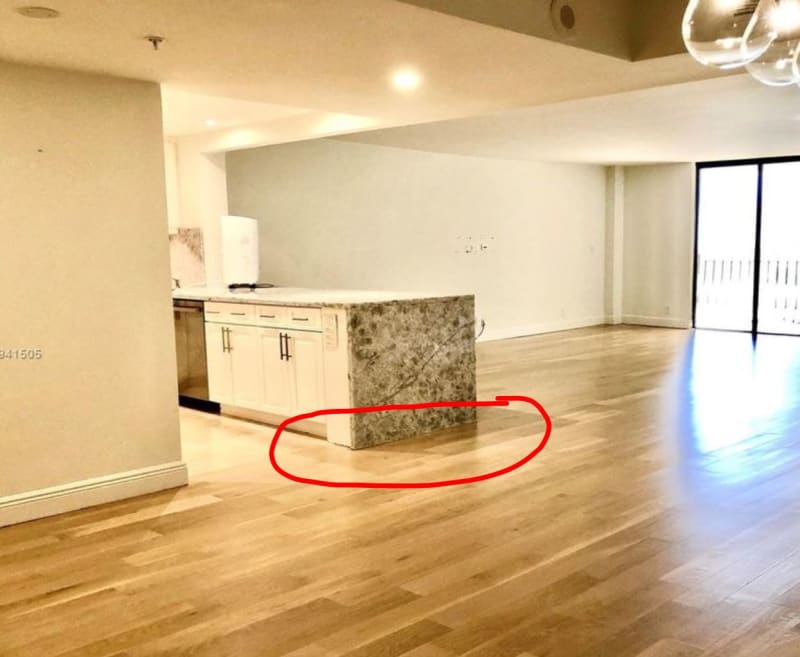
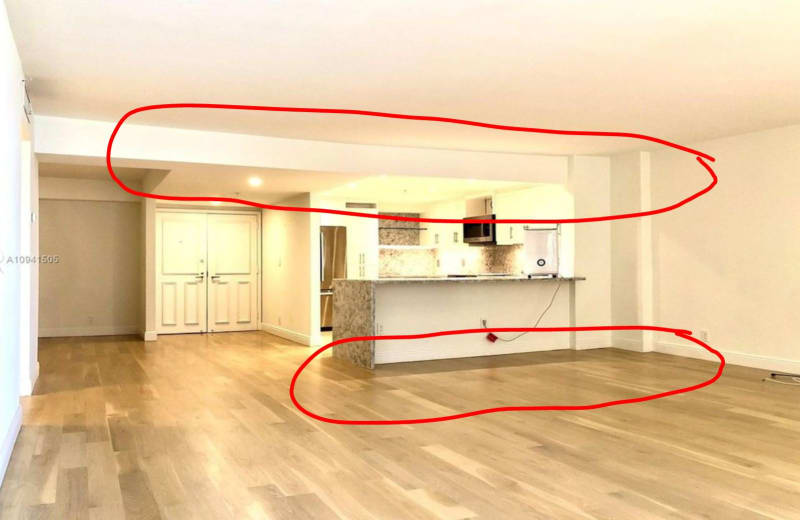
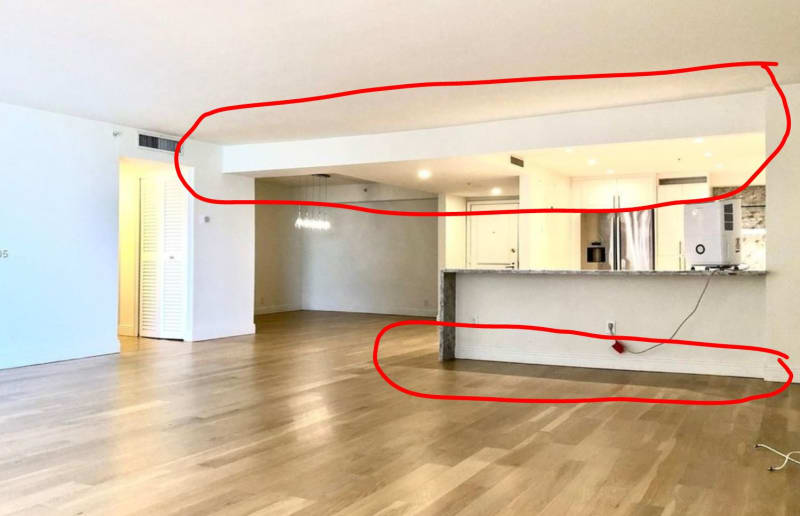
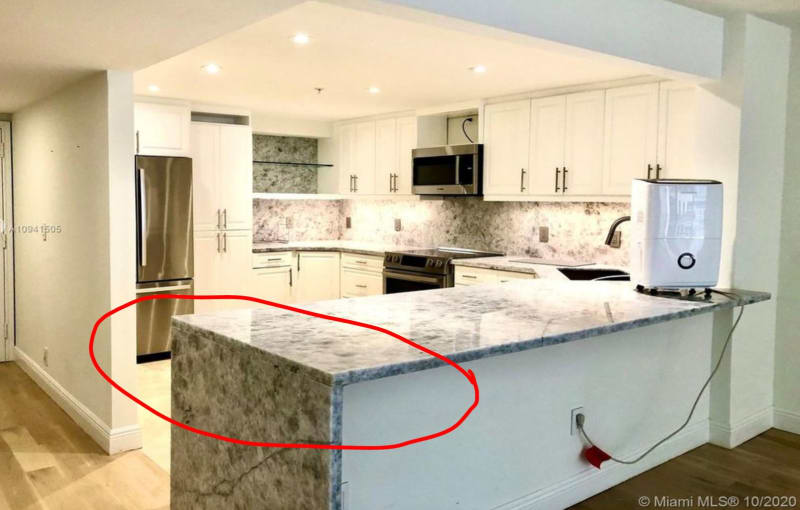
The pool deck collapse relies on a theory that the pool deck collapsed and the columns adjacent were exposed and failed, they fail to recognize the pool slab stepped 2-4 feet at these columns and the slabs were not continuous.
The tick tock video clearly shows something over the garage ramp.
Dust from above in Unit 711 would not have been caused by a pool slab collapse - the short-sightedness of the posters here re: pool deck is concerning. I'm an architect with extensive structural experience on many $100+ million jobs. Obviously, the slabs were thin and the floor slabs would be PT today, but the podium slab most likely wouldn't be and at that thickness was clearly not overloaded. The damage to the columns that held on the existing building clearly shows the pool deck collapsed due to the main collapse due to the angled concrete on the south side.
There was a post above about the podium slab having additional pavers, but the photos show tiles, so I'm not sure what this is about.
There was clear deflection in unit 1010 prior to collapse, the mislabeled column I found (see post above) is between the coat closet and laundry in the photos below - this deflection is more than normal in concrete (in steel is this is more normal in a long span.)




The lobby where she stood watching the cars fall looks like this and she was at approximately the red X. The hallway in the rear goes to her unit, it is likely she saw her daughter there, it does not sound like she ran back into her unit. She could not see the first collapse from this vantage point at all!
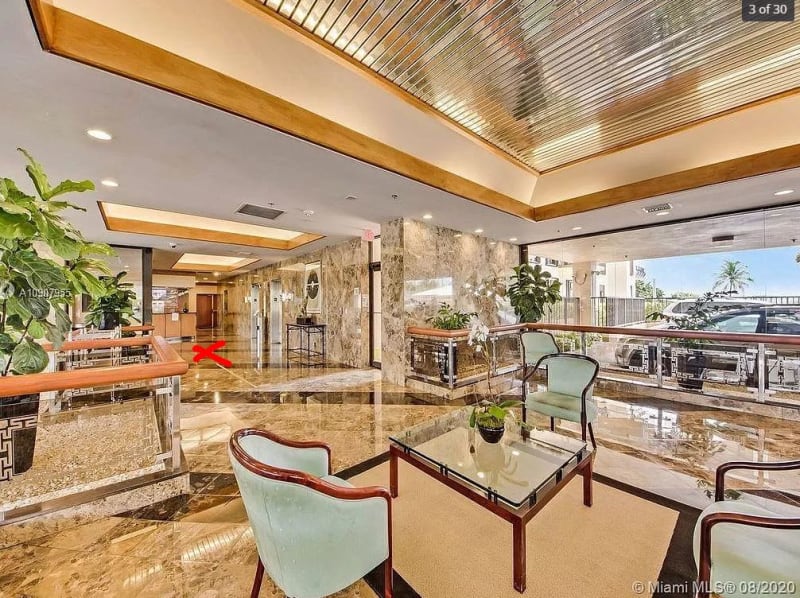

- Thread starter
- #145
-
1
- Thread starter
- #146
Letter from the occupants...
Rather than think climate change and the corona virus as science, think of it as the wrath of God. Feel any better?
-Dik
Rather than think climate change and the corona virus as science, think of it as the wrath of God. Feel any better?
-Dik
-
1
- #147
I found it concerning how easily the garage/pool area slabs detached from the perimeter wall, given that the notes call for #5 hook bars @12” oc (I don’t see any in the photos). I also have not found any section/details for how that perimeter wall is reinforced.
As previous posters stated, this slab was acting as a diaphragm to transfer lateral loads for the building and I would expect the connections to the exterior wall to be important to properly transfer those forces.
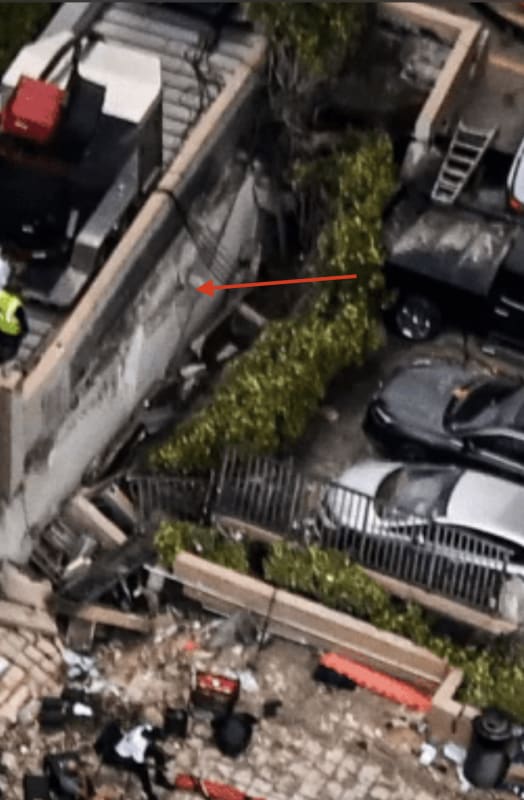
As previous posters stated, this slab was acting as a diaphragm to transfer lateral loads for the building and I would expect the connections to the exterior wall to be important to properly transfer those forces.

-
1
- #148
Retrograde
Structural
warrenslo said:No, there are three forces in a column, slenderness, punching, and axial.
Slenderness is not a force, and punching (shear) is in the slab, not the column.
warrenslo said:There was clear deflection in unit 1010 prior to collapse
To me, those photos do not indicate clear deflection.
DB27 said:As previous posters stated, this slab was acting as a diaphragm to transfer lateral loads for the building and I would expect the connections to the exterior wall to be important to properly transfer those forces.
While this is possible, I think the roof work + additional stone/tile/marble within units + HVAC equipment + aging of the building contributed. To date there is nothing I see conclusively stating the parking/pool deck collapsed FIRST. Every witness didn't have a clear view. The damage pattern (look at Vegas implosion patterns) is clearly due to the rest of the building falling on it, otherwise the pool would have fell slightly as well. It didn't it's solid. Beginning to think there are shills on this forum...
-
1
- #151
I think it's pretty clear at this point that multiple bays of the lobby level (as it is called on the structural drawings ca. 1979) failed first. AtomixPro's video looking down the garage ramp at the debris/waterline, and the eyewitness accounts as described/recounted above tells us that at SOME point, perhaps minutes prior to the superstructure collapse, portions of the lobby level slab had collapsed. One south of the garage ramp ('tiktok video'), and one in the guest parking area (eyewitness account, see above).
I think we have also established that the first part of the superstructure to fail was either column I/9.1 or K/9.1. (or generally the column area, or tributary, or perhaps the influence zone). That said, it's still not entirely clear if the columns interior of grid 9.1 (grid 8/7) failed even before that, which would be closer to the ramp area slab failure (per the 'tiktok' video). But, video of the collapse appears to show the column(s) at grid (I or K)/8 still supporting the roof just after the collapse begins.
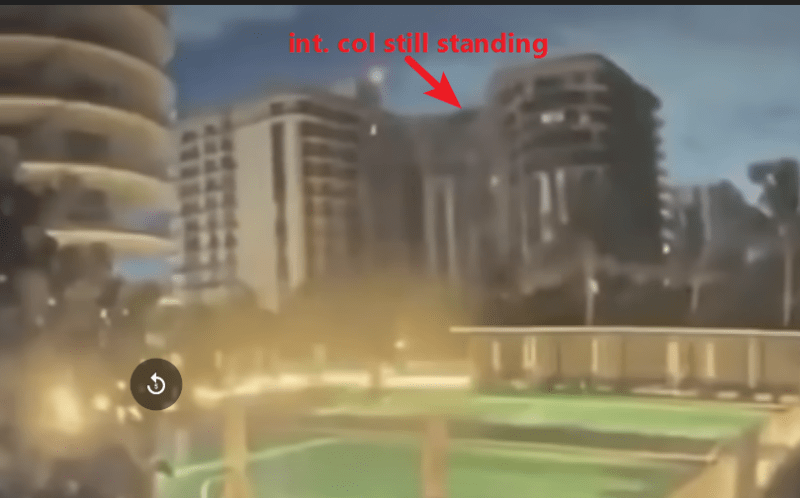
Regarding the columns that may have been in contact with soil in the planters: I have found a particularly interesting item. See clips below. Both of these columns were not only located at/in/part of the planter, but the planters were irrigated (I never considered that plants need water). Clips from pages A2C-1.0 and LR-1 of the renovation drawings.
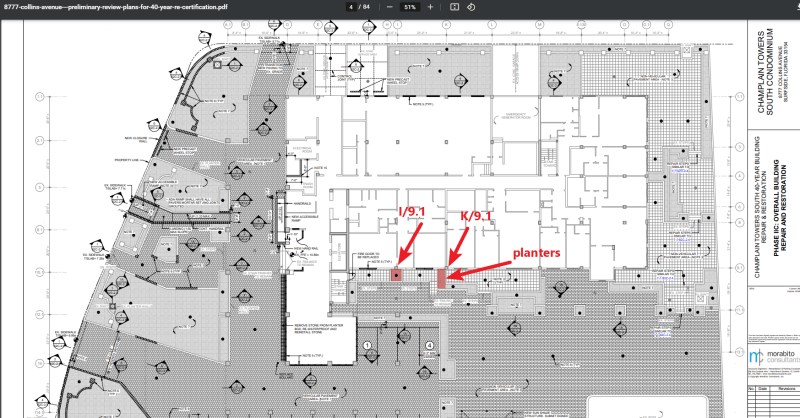
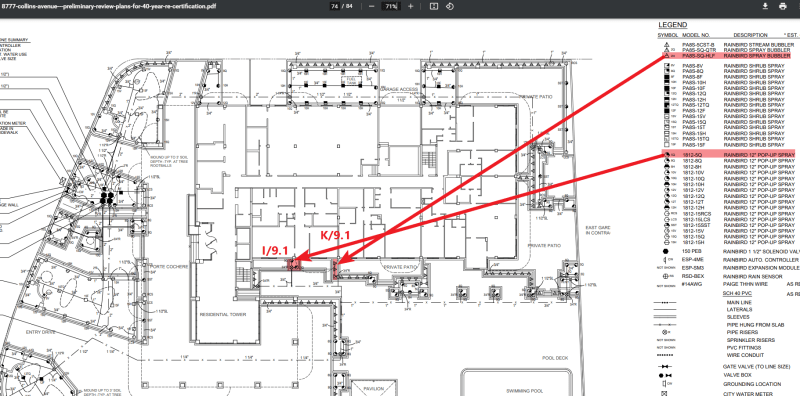
I think there's some merit to this idea.
see [Jun 21 00:49]
I think we have also established that the first part of the superstructure to fail was either column I/9.1 or K/9.1. (or generally the column area, or tributary, or perhaps the influence zone). That said, it's still not entirely clear if the columns interior of grid 9.1 (grid 8/7) failed even before that, which would be closer to the ramp area slab failure (per the 'tiktok' video). But, video of the collapse appears to show the column(s) at grid (I or K)/8 still supporting the roof just after the collapse begins.

Regarding the columns that may have been in contact with soil in the planters: I have found a particularly interesting item. See clips below. Both of these columns were not only located at/in/part of the planter, but the planters were irrigated (I never considered that plants need water). Clips from pages A2C-1.0 and LR-1 of the renovation drawings.


warrenslo said:The pool deck collapse relies on a theory that the pool deck collapsed and the columns adjacent were exposed and failed, they fail to recognize the pool slab stepped 2-4 feet at these columns and the slabs were not continuous.
I think there's some merit to this idea.
see [Jun 21 00:49]
dold said:'...
Looking at the video it appears that the column on grid I/9.1 was the first to go, although I can't see the interior columns to the north.
...
1) this looks like a low point (+10'-10" only open to the pool area to the east) where the slab would seem to be at higher risk of corrosion. ;
2) there is a 2'-6" step in the slab at this column joint.
2.a) this leaves a decent offset between a potential lateral load implied by a failed slab panel (possibly yellow area?), and the restraint at the primary deck at +13'-4".
...
Next, perhaps since all the columns along grid 9.1 are tied together with a beam at the slab step, if column I/9.1 (i.e. "the suspect column") collapsed first, that could potentially mobilize a force on grid 9.1 columns acting to the west, with load path bonus from the steel in the perimeter beam.
This seems to be reflected to some extent in the collapse video - the columns along grid 9.1 are among the first to go, starting at the suspect column and propagating east.
-
10
- #152
warrenslo said:otherwise the pool would have fell slightly as well.
The pool is supported by walls that extend to the foundation. Look at the drawings.
warrenslo said:To date there is nothing I see conclusively stating the parking/pool deck collapsed FIRST. Every witness didn't have a clear view.
There is a clear video posted above that shows a collapsed lobby level slab just south of the garage entrance ramp. Before the main collapse.
warrenslo said:And, I've always been taught to calculate punching as part of a column. Otherwise why are column caps centered around columns? Seems like you are being protectively picky...
Beginning to think there are shills on this forum...
...Because the structural engineers that you are calling "shills" don't agree that the three forces in a column are "slenderness, punching, and axial", etc.? We're trying to have a discussion about this building collapse. We're not having a contest. We're trying to keep the discussion informed with sound technical information, not 'things you learned somewhere once'.
-
1
- #153
I don’t understand the objection to the bars unzipping? Why would this require defective concrete or other defects? A bar is much stronger in shear than concrete at that edge distance, so why can’t a bar simply rip out? If a column collapsed and a mid span went into negative bending and formed a hinge, then ripping out of bars as the hinge opened is what you’d expect. Like when you snap a piece of celery and the threads tear thru the fresh.
-
5
- #154
microwizard
Computer
warrenslo said:There was clear deflection in unit 1010 prior to collapse, the mislabeled column I found (see post above) is between the coat closet and laundry in the photos below - this deflection is more than normal in concrete (in steel is this is more normal in a long span.)
I would be surprised if you didn't know that interior shots are often taken with a wide angle lens which introduce distortion to the image. Unless you know what lens was used you can not rely on these images for analysis.
Also, please don't leap to accuse people of being shills because they disagree with you.
LittleInch
Petroleum
This discussion is very interesting to a lot of people and is one of the great pluses for this site I feel.
Question here - Could it be possible for column L10 to have failed first, but the initial impact seen was on the adjacent pool deck?
I still find it difficult to believe that failure of a single column can bring down a building, but if that one column failed and then that led to the pool area slab pulling away from the external wall and then rippling the failure across the deck area as witnessed by a number of people then that effect went into other columns?
The failure may have started at the pool deck area, but I think a lot of people are trying to work out why and not seeing a good reason.
The column in question looks on this plan view from a post above to be the most vulnerable to anyone entering down the ramp and running into it. Coupled with apparent surface water ponding over the years maybe it simply failed first?
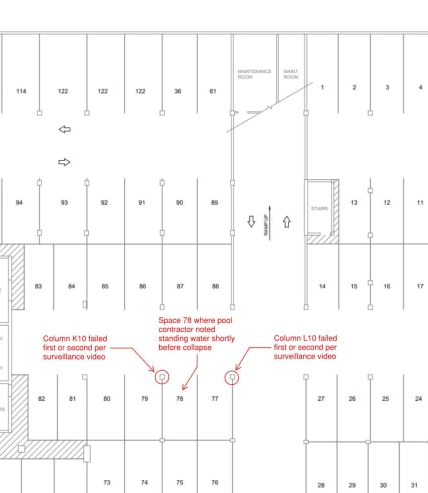
Remember - More details = better answers
Also: If you get a response it's polite to respond to it.
Question here - Could it be possible for column L10 to have failed first, but the initial impact seen was on the adjacent pool deck?
I still find it difficult to believe that failure of a single column can bring down a building, but if that one column failed and then that led to the pool area slab pulling away from the external wall and then rippling the failure across the deck area as witnessed by a number of people then that effect went into other columns?
The failure may have started at the pool deck area, but I think a lot of people are trying to work out why and not seeing a good reason.
The column in question looks on this plan view from a post above to be the most vulnerable to anyone entering down the ramp and running into it. Coupled with apparent surface water ponding over the years maybe it simply failed first?

Remember - More details = better answers
Also: If you get a response it's polite to respond to it.
-
1
- #157
If left you kids alone for half a day, and you posted like crazy and had shill battles... (edited because I hit Submit instead of Preview, wish this site would implement recalling an accidental post)
The objective of all engineers is to not make something fail-proof, but rather, fail-safe.
It is impossible to avoid failure. Fail-safe does not mean something will not fail. It means when it does fail eventfully, it will still be safe (meaning not costing human life).
We will never be able to convince society something is going to fail until it does. In college I was trained people respond to deflection, even if such deflection is within specs. I I remember freaking out as a kid my first time flying on a jetliner after seeing the wings deflect in flight. So critical designs should show warnings. A radical idea would be to add non-structural elements to a building that shatter and collapse as a warning.
The real culprit is not that the building was too weak - it was too strong and did not show real concrete signs of distress so people would self evacuate. (Or the column design could have been totally and completely wrong) In this condo, those that got warning, got out alive. We are must learn, the police, government inspectors, will not protect us. Firefighters will, but they are always after the fact.
The objective of all engineers is to not make something fail-proof, but rather, fail-safe.
It is impossible to avoid failure. Fail-safe does not mean something will not fail. It means when it does fail eventfully, it will still be safe (meaning not costing human life).
We will never be able to convince society something is going to fail until it does. In college I was trained people respond to deflection, even if such deflection is within specs. I I remember freaking out as a kid my first time flying on a jetliner after seeing the wings deflect in flight. So critical designs should show warnings. A radical idea would be to add non-structural elements to a building that shatter and collapse as a warning.
The real culprit is not that the building was too weak - it was too strong and did not show real concrete signs of distress so people would self evacuate. (Or the column design could have been totally and completely wrong) In this condo, those that got warning, got out alive. We are must learn, the police, government inspectors, will not protect us. Firefighters will, but they are always after the fact.
...roof work + additional stone/tile/marble within units + HVAC equipment + aging of the building contributed.
This would be a good idea to pursue. The additional loading of the heavy flooring and countertops can be estimated easily. In the 80's it was all shag and Formica. Many of the balconies had tile added which to me is not ever a good idea.
Do we know what the actual design loads were and how they compare with modern-day assumptions? For example, going to the tables of ASCE 7 the assumptions for LL are baked into the intended use of the space. Dead loads are calculated and include some level of finishes, cladding, and permanent equipment. But where did they draw the line between DL and LL in 1981 and how exactly was DL calculated? Were countertops and flooring considered DL? Were they plugged in from some table in some predecessor standard? If so did that standard assume all shag and Formica? This is something about the history of our profession that I'm admittedly uninformed about.
Bradley Wilder, P.E.
Construction P.E. (KY), MBA
Bridge Rehab, Coatings, Structural Repair
Bradley Wilder, P.E.
Construction P.E. (KY), MBA
Bridge Rehab, Coatings, Structural Repair
jrs as structural engineers we generally don't design for fail safe. The exception would be requirements for progressive collapse design for critical federal buildings. Even those requirements are relatively new and were the result of the OKC bombing. There isn't an engineer on the planet that would typically look at load transfer if a column was removed for example.
In most buildings there are members that if they fail completely the consequences would not be good. The saving grace for us as structural engineers is the fact we generally try to design so we have ductile failure mechanisms and for brittle failures (like punching shear) there is a higher factor of safety applied since the failure is generally without warning.
One thing with buildings, even when there is a failure of a critical element most of the time you see localized failures only and the building finds a different load path that wasn't intended but was there. The buildings are much smarter than we are....![[bigsmile] [bigsmile] [bigsmile]](/data/assets/smilies/bigsmile.gif) .
.
In most buildings there are members that if they fail completely the consequences would not be good. The saving grace for us as structural engineers is the fact we generally try to design so we have ductile failure mechanisms and for brittle failures (like punching shear) there is a higher factor of safety applied since the failure is generally without warning.
One thing with buildings, even when there is a failure of a critical element most of the time you see localized failures only and the building finds a different load path that wasn't intended but was there. The buildings are much smarter than we are....
![[bigsmile] [bigsmile] [bigsmile]](/data/assets/smilies/bigsmile.gif) .
.- Status
- Not open for further replies.
Similar threads
- Replies
- 4
- Views
- 22K
- Locked
- Question
- Replies
- 120
- Views
- 15K
- Replies
- 4
- Views
- 748
- Locked
- Question
- Replies
- 1
- Views
- 2K
- Locked
- Question
- Replies
- 4
- Views
- 5K
